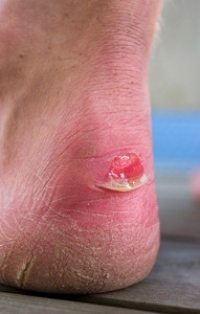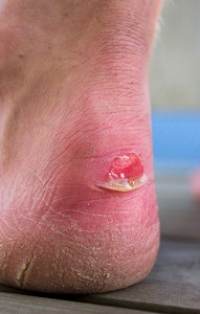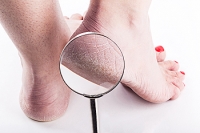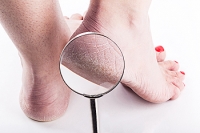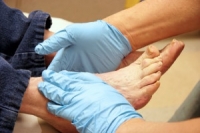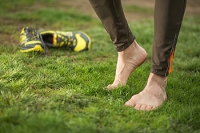
Blog (817)
Children and Their Fist Pair of Shoes
The bones in babies feet are flexible as a result of being underdeveloped. This is how most babies are born, and they appear to be flat footed. As walking begins, the bones, muscles, and tendons will gradually become stronger, and the arch will typically develop. While toddlers are indoors, it is beneficial for them to walk barefoot. This is helpful in strengthening the foot as the toes grasp the floor. When it is time for shoes to be purchased, it is important that your child’s feet are measured correctly, as this generally ensures shoes that fit properly are worn. The shoes need to have adequate room for the toes to move freely in, and the soles should be constructed of a flat and flexible sole. If you would like additional information about how to buy children’s shoes, it is suggested to consult with a podiatrist.
Making sure that your children maintain good foot health is very important as they grow. If you have any questions, contact Dr. Kenneth Donovan of Advanced Care Foot and Ankle. Our doctor can provide the care you need to keep you pain-free and on your feet.
Keeping Children's Feet Healthy
Having healthy feet during childhood can help prevent medical problems later in life, namely in the back and legs. As children grow, their feet require different types of care. Here are some things to consider…
Although babies do not walk yet, it is still very important to take care of their feet.
Avoid putting tight shoes or socks on his or her feet.
Allow the baby to stretch and kick his or her feet to feel comfortable.
As a toddler, kids are now on the move and begin to develop differently. At this age, toddlers are getting a feel for walking, so don’t be alarmed if your toddler is unsteady or ‘walks funny’.
As your child gets older, it is important to teach them how to take care of their feet.
Show them proper hygiene to prevent infections such as fungus.
Be watchful for any pain or injury.
Have all injuries checked by a doctor as soon as possible.
Comfortable, protective shoes should always be worn, especially at play.
If you have any questions please feel free to contact one of our offices located in Warren, Livingston, and Toms River, NJ . We offer the newest diagnostic and treatment technologies for all your foot and ankle needs.
Read more about What to Do to Keep Your Child’s Feet Healthy
Why Do Blisters Develop?
Many people who enjoy running and hiking can experience unpleasant blisters forming on their feet. This is often a result of friction that happens from the shoes or socks rubbing against the skin. The first layer of skin will typically become damaged, and a small pocket of fluid will form over the raw area. This acts as a natural barrier for protection, and will gradually drain as the healing process occurs. A successful measure that can be implemented which can help to prevent painful blisters from developing can include wearing shoes and socks that fit correctly. This will help in making sure there is adequate room so the heel does not rub on the back of the shoe. If the blister should become injured and drain before the skin has healed, an infection may occur. If this occurs, it is important to cover the affected area with a bandage until the skin has completely healed. If you are frequently getting foot blisters, it is advised to speak to a podiatrist who can guide you toward proper shoe fitting.
Blisters are prone to making everyday activities extremely uncomfortable. If your feet are hurting, contact Dr. Kenneth Donovan of Advanced Care Foot and Ankle. Our doctor can provide the care you need to keep you pain-free and on your feet.
Foot Blisters
Foot blisters develop as a result of constantly wearing tight or ill-fitting footwear. This happens due to the constant rubbing from the shoe, which can often lead to pain.
What Are Foot Blisters?
A foot blister is a small fluid-filled pocket that forms on the upper-most layer of the skin. Blisters are filled with clear fluid and can lead to blood drainage or pus if the area becomes infected.
How Do Blisters Form?
Blisters on the feet are often the result of constant friction of skin and material, usually by shoe rubbing. Walking in sandals, boots, or shoes that don’t fit properly for long periods of time can result in a blister. Having consistent foot moisture and humidity can easily lead to blister formation.
Prevention & Treatment
It is important to properly care for the affected area in order to prevent infection and ease the pain. Do not lance the blister and use a Band-Aid to provide pain relief. Also, be sure to keep your feet dry and wear proper fitting shoes. If you see blood or pus in a blister, seek assistance from a podiatrist.
If you have any questions, please feel free to contact one of our offices located in Warren, Livingston, and Toms River, NJ. We offer the newest diagnostic and treatment technologies for all your foot care needs.
Why Do Blisters Develop?
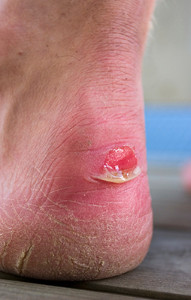 Many people who enjoy running and hiking can experience unpleasant blisters forming on their feet. This is often a result of friction that happens from the shoes or socks rubbing against the skin. The first layer of skin will typically become damaged, and a small pocket of fluid will form over the raw area. This acts as a natural barrier for protection, and will gradually drain as the healing process occurs. A successful measure that can be implemented which can help to prevent painful blisters from developing can include wearing shoes and socks that fit correctly. This will help in making sure there is adequate room so the heel does not rub on the back of the shoe. If the blister should become injured and drain before the skin has healed, an infection may occur. If this occurs, it is important to cover the affected area with a bandage until the skin has completely healed. If you are frequently getting foot blisters, it is advised to speak to a podiatrist who can guide you toward proper shoe fitting.
Many people who enjoy running and hiking can experience unpleasant blisters forming on their feet. This is often a result of friction that happens from the shoes or socks rubbing against the skin. The first layer of skin will typically become damaged, and a small pocket of fluid will form over the raw area. This acts as a natural barrier for protection, and will gradually drain as the healing process occurs. A successful measure that can be implemented which can help to prevent painful blisters from developing can include wearing shoes and socks that fit correctly. This will help in making sure there is adequate room so the heel does not rub on the back of the shoe. If the blister should become injured and drain before the skin has healed, an infection may occur. If this occurs, it is important to cover the affected area with a bandage until the skin has completely healed. If you are frequently getting foot blisters, it is advised to speak to a podiatrist who can guide you toward proper shoe fitting.
Blisters are prone to making everyday activities extremely uncomfortable. If your feet are hurting, contact Dr. Kenneth Donovan of Advanced Care Foot and Ankle. Our doctor can provide the care you need to keep you pain-free and on your feet.
Foot Blisters
Foot blisters develop as a result of constantly wearing tight or ill-fitting footwear. This happens due to the constant rubbing from the shoe, which can often lead to pain.
What Are Foot Blisters?
A foot blister is a small fluid-filled pocket that forms on the upper-most layer of the skin. Blisters are filled with clear fluid and can lead to blood drainage or pus if the area becomes infected.
How Do Blisters Form?
Blisters on the feet are often the result of constant friction of skin and material, usually by shoe rubbing. Walking in sandals, boots, or shoes that don’t fit properly for long periods of time can result in a blister. Having consistent foot moisture and humidity can easily lead to blister formation.
Prevention & Treatment
It is important to properly care for the affected area in order to prevent infection and ease the pain. Do not lance the blister and use a Band-Aid to provide pain relief. Also, be sure to keep your feet dry and wear proper fitting shoes. If you see blood or pus in a blister, seek assistance from a podiatrist.
If you have any questions, please feel free to contact one of our offices located in Warren, Livingston, and Toms River, NJ . We offer the newest diagnostic and treatment technologies for all your foot care needs.
Arthritis Can Cause Pain in the Feet and Ankles
Arthritis Can Cause Pain in the Feet and Ankles
Possible Causes of Cracked Heels
The medical condition that is referred to as cracked heels originates from having extremely dry skin on the heel area of the foot. This can come from standing for extended periods of time throughout the day, or from having certain medical conditions that may include psoriasis. Many people who are overweight experience cracked heels, as a result of the added weight the feet must endure. Additionally, if open back shoes are frequently worn, this condition may develop due to inadequate support these types of shoes provide. The symptoms that are often associated with this ailment include a thickening of skin on the outside of the heel. The skin may turn a dark brown or yellowish color, and cracks in the skin can develop as weight is placed on the heel. This affliction can cause severe pain and discomfort. Mild relief may be found when the feet are washed and dried daily, followed by thoroughly moisturizing them. If you have developed cracked heels, it is advised to consult with a podiatrist who can guide you toward healing and prevention techniques.
If the skin on your feet starts to crack, you may want to see a podiatrist to find treatment. If you have any concerns, contact Dr. Kenneth Donovan from Advanced Care Foot and Ankle. Our doctor can provide the care you need to keep you pain-free and on your feet.
Cracked Heels
It is important to moisturize your cracked heels in order to prevent pain, bleeding, and infection. The reason cracked heels form is because the skin on the foot is too dry to support the immense pressure placed on them. When the foot expands, the dry skin on the foot begins to split.
Ways to Help Heal Them
- Invest in a good foot cream
- Try Using Petroleum Jelly
- Ease up on Soaps
- Drink Plenty of Water
Ways to Prevent Cracked Heels
- Moisturize After Showering
- Skip a Shower
- Keep Shower Water Lukewarm
- Don’t Scrub Your Feet
If you are unsure how to proceed in treating cracked heels, seek guidance from a podiatrist.
Your doctor will help you with any questions or information you may need.
If you have any questions, please feel free to contact one of our offices located in Warren, Livingston, and Toms River, NJ. We offer the newest diagnostic and treatment technologies for all your foot care needs.
Possible Causes of Cracked Heels
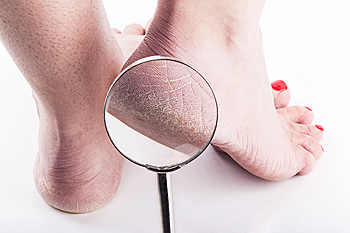 The medical condition that is referred to as cracked heels originates from having extremely dry skin on the heel area of the foot. This can come from standing for extended periods of time throughout the day, or from having certain medical conditions that may include psoriasis. Many people who are overweight experience cracked heels, as a result of the added weight the feet must endure. Additionally, if open back shoes are frequently worn, this condition may develop due to inadequate support these types of shoes provide. The symptoms that are often associated with this ailment include a thickening of skin on the outside of the heel. The skin may turn a dark brown or yellowish color, and cracks in the skin can develop as weight is placed on the heel. This affliction can cause severe pain and discomfort. Mild relief may be found when the feet are washed and dried daily, followed by thoroughly moisturizing them. If you have developed cracked heels, it is advised to consult with a podiatrist who can guide you toward healing and prevention techniques.
The medical condition that is referred to as cracked heels originates from having extremely dry skin on the heel area of the foot. This can come from standing for extended periods of time throughout the day, or from having certain medical conditions that may include psoriasis. Many people who are overweight experience cracked heels, as a result of the added weight the feet must endure. Additionally, if open back shoes are frequently worn, this condition may develop due to inadequate support these types of shoes provide. The symptoms that are often associated with this ailment include a thickening of skin on the outside of the heel. The skin may turn a dark brown or yellowish color, and cracks in the skin can develop as weight is placed on the heel. This affliction can cause severe pain and discomfort. Mild relief may be found when the feet are washed and dried daily, followed by thoroughly moisturizing them. If you have developed cracked heels, it is advised to consult with a podiatrist who can guide you toward healing and prevention techniques.
If the skin on your feet starts to crack, you may want to see a podiatrist to find treatment. If you have any concerns, contact Dr. Kenneth Donovan from Advanced Care Foot and Ankle. Our doctor can provide the care you need to keep you pain-free and on your feet.
Cracked Heels
It is important to moisturize your cracked heels in order to prevent pain, bleeding, and infection. The reason cracked heels form is because the skin on the foot is too dry to support the immense pressure placed on them. When the foot expands, the dry skin on the foot begins to split.
Ways to Help Heal Them
- Invest in a good foot cream
- Try Using Petroleum Jelly
- Ease up on Soaps
- Drink Plenty of Water
Ways to Prevent Cracked Heels
- Moisturize After Showering
- Skip a Shower
- Keep Shower Water Lukewarm
- Don’t Scrub Your Feet
If you are unsure how to proceed in treating cracked heels, seek guidance from a podiatrist. Your doctor will help you with any questions or information you may need.
If you have any questions, please feel free to contact one of our offices located in Warren, Livingston, and Toms River, NJ . We offer the newest diagnostic and treatment technologies for all your foot care needs.
Feet Tips For Diabetics
Diabetics are at increased risk for foot complications, as many diabetics have reduced blood flow and damaged nerves. There are a few measures to take to protect your feet. First, examine your feet daily. If you cannot see your feet completely, use a mirror or have someone assist you. Look for cuts, discoloration, and sores. Make sure your toenails are cut and filed as well. Additionally, do not walk barefoot. You should assure that the lining on your shoes and socks are smooth before wearing them. Another step to remember is to avoid subjecting your feet to extreme temperatures. Check showers or bodies of water before entering. When possible, elevate your legs and wiggle your toes in order to help your circulation. Remembering these tips could prevent amputation, or even life-threatening complications. Diabetics should be going to a podiatrist twice a year for an exam, as well as speaking with a podiatrist when questions arise.
Diabetic Limb Salvage
Diabetic limb salvage can be an effective way in preventing the need for limb amputation. If you have a foot ulcer and diabetes, consult with Dr. Kenneth Donovan from Advanced Care Foot and Ankle. Our doctor will assess your condition and provide you with quality foot and ankle treatment.
What Is Diabetic Limb Salvage?
Diabetic limb salvage is the attempt of saving a limb, such as the foot, that has an infected ulcer, from amputation. Podiatrists also try to make sure that there is enough function in the foot after the salvage that it is still usable. Those with diabetes experience poor blood circulation, which prevents proper healing of an ulcer. If the ulcer is left uncheck, it could become infected, which could result in the need for amputation.
Diabetes is the number one cause of non-traumatic amputations in the United States. Amputation has been found to lead to higher mortality rates. This translates into higher healthcare costs, and a reduced quality of life and mobility for amputees. Podiatrists have attempted to increase the prevalence of limb salvage in an attempt to solve these issues.
Diagnosis and Treatment
Limb salvage teams have grown in recent years that utilize a number of different treatments to save the infected limb. This includes podiatrists that specialize in wound care, rehabilitation, orthotics, and surgery. Through a combination of these methods, limb salvage has been found to be an effective treatment for infected limbs, and as an alternative to amputation. Podiatrists will first evaluate the potential for limb salvage and determine if the limb can be saved or must be amputated.
If you have any questions, please feel free to contact one of our offices located in Warren, Livingston, and Toms River, NJ. We offer the newest diagnostic and treatment technologies for all your foot care needs.
Feet Tips For Diabetics
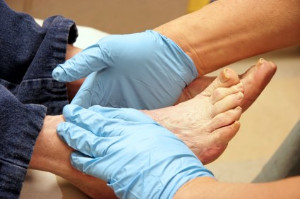 Diabetics are at increased risk for foot complications, as many diabetics have reduced blood flow and damaged nerves. There are a few measures to take to protect your feet. First, examine your feet daily. If you cannot see your feet completely, use a mirror or have someone assist you. Look for cuts, discoloration, and sores. Make sure your toenails are cut and filed as well. Additionally, do not walk barefoot. You should assure that the lining on your shoes and socks are smooth before wearing them. Another step to remember is to avoid subjecting your feet to extreme temperatures. Check showers or bodies of water before entering. When possible, elevate your legs and wiggle your toes in order to help your circulation. Remembering these tips could prevent amputation, or even life-threatening complications. Diabetics should be going to a podiatrist twice a year for an exam, as well as speaking with a podiatrist when questions arise.
Diabetics are at increased risk for foot complications, as many diabetics have reduced blood flow and damaged nerves. There are a few measures to take to protect your feet. First, examine your feet daily. If you cannot see your feet completely, use a mirror or have someone assist you. Look for cuts, discoloration, and sores. Make sure your toenails are cut and filed as well. Additionally, do not walk barefoot. You should assure that the lining on your shoes and socks are smooth before wearing them. Another step to remember is to avoid subjecting your feet to extreme temperatures. Check showers or bodies of water before entering. When possible, elevate your legs and wiggle your toes in order to help your circulation. Remembering these tips could prevent amputation, or even life-threatening complications. Diabetics should be going to a podiatrist twice a year for an exam, as well as speaking with a podiatrist when questions arise.
Diabetic Limb Salvage
Diabetic limb salvage can be an effective way in preventing the need for limb amputation. If you have a foot ulcer and diabetes, consult with Dr. Kenneth Donovan from Advanced Care Foot and Ankle. Our doctor will assess your condition and provide you with quality foot and ankle treatment.
What Is Diabetic Limb Salvage?
Diabetic limb salvage is the attempt of saving a limb, such as the foot, that has an infected ulcer, from amputation. Podiatrists also try to make sure that there is enough function in the foot after the salvage that it is still usable. Those with diabetes experience poor blood circulation, which prevents proper healing of an ulcer. If the ulcer is left uncheck, it could become infected, which could result in the need for amputation.
Diabetes is the number one cause of non-traumatic amputations in the United States. Amputation has been found to lead to higher mortality rates. This translates into higher healthcare costs, and a reduced quality of life and mobility for amputees. Podiatrists have attempted to increase the prevalence of limb salvage in an attempt to solve these issues.
Diagnosis and Treatment
Limb salvage teams have grown in recent years that utilize a number of different treatments to save the infected limb. This includes podiatrists that specialize in wound care, rehabilitation, orthotics, and surgery. Through a combination of these methods, limb salvage has been found to be an effective treatment for infected limbs, and as an alternative to amputation. Podiatrists will first evaluate the potential for limb salvage and determine if the limb can be saved or must be amputated.
If you have any questions, please feel free to contact one of our offices located in Warren, Livingston, and Toms River, NJ . We offer the newest diagnostic and treatment technologies for all your foot care needs.
Read more about Diabetic Limb SalvageHabits That Can Help to Prevent Running Injuries
Research has shown it is beneficial for runners to develop habits that may help to prevent running injuries. Warming up before a run can improve range of motion and improve flexibility. Many runners find it helpful to begin their run with a purpose. This may include focusing on speed one day, and endurance the next day, in addition to deciding on what type of road to run on. Implementing breathing techniques may help to reduce any stiffness and tension that has developed during the run. It is important to stretch the body daily before a running practice begins, as this can help the hips, ankles and knees to remain flexible. If you would like additional information about how to prevent running injuries, it is suggested to counsel with a podiatrist, who can provide you with the correct techniques.
All runners should take extra precaution when trying to avoid injury. If you have any concerns about your feet, contact Dr. Kenneth Donovan of Advanced Care Foot and Ankle. Our doctor will treat your foot and ankle needs.
How to Prevent Running Injuries
There are a lot of mistakes a runner can make prior to a workout that can induce injury. A lot of athletes tend to overstretch before running, instead of saving those workouts for a post-run routine. Deep lunges and hand-to-toe hamstring pulls should be performed after a workout instead of during a warmup. Another common mistake is jumping into an intense routine before your body is physically prepared for it. You should try to ease your way into long-distance running instead of forcing yourself to rush into it.
More Tips for Preventing Injury
- Incorporate Strength Training into Workouts – This will help improve the body’s overall athleticism
- Improve and Maintain Your Flexibility – Stretching everyday will help improve overall performance
- “Warm Up” Before Running and “Cool Down” Afterward – A warm up of 5-10 minutes helps get rid of lactic acid in the muscles and prevents delayed muscle soreness
- Cross-Training is Crucial
- Wear Proper Running Shoes
- Have a Formal Gait Analysis – Poor biomechanics can easily cause injury
If you have any questions, please feel free to contact one of our offices located in Warren, Livingston, and Toms River, NJ . We offer the newest diagnostic and treatment technologies for all your foot care needs.

